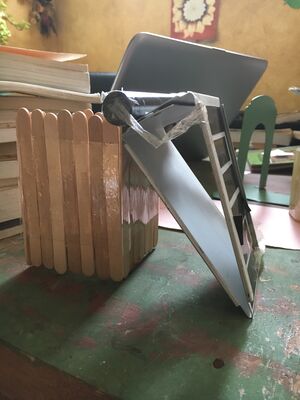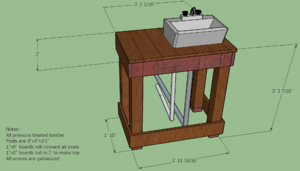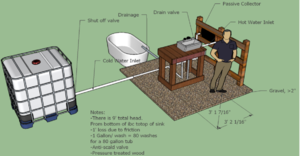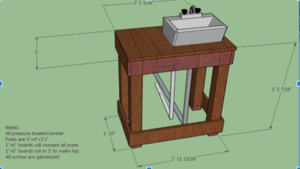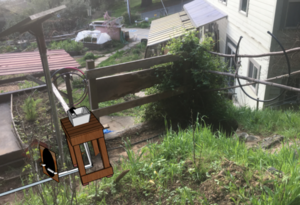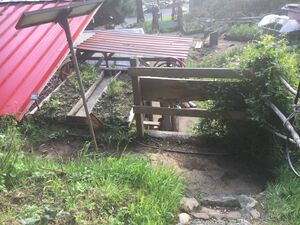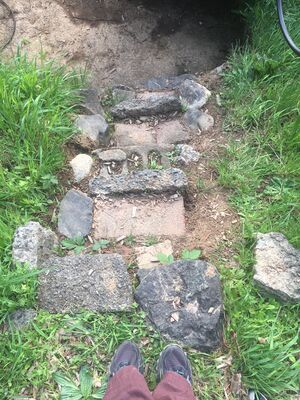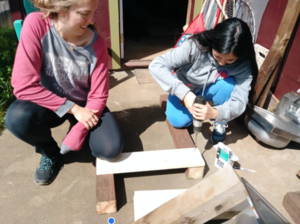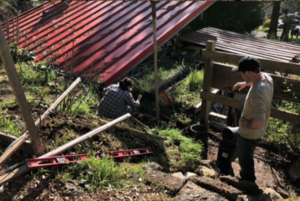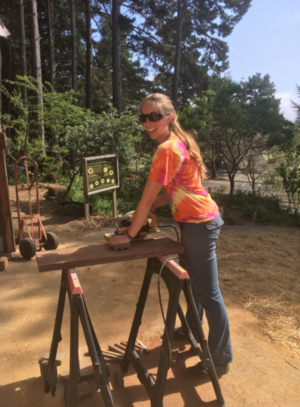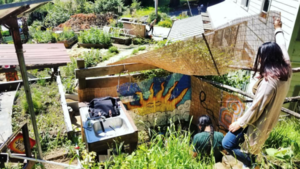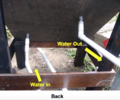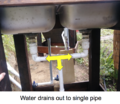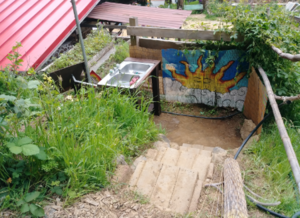
Abstract
CCAT volunteers and co-directors frequently deal with dirty hands and muddy shoes from working outside. Typically, they use the outdoor hose to rinse their shoes, causing flooding and mud build-up in traffic areas. The use of solar heated shower was thought to be the solution to this problem, but was soon realized to be infeasible. The solution to this problem was inspired by the solar heated shower called outdoor solar heated sink. This solution was found feasible due to the availability of materials for a sink washing station.
Background[edit | edit source]
We were assigned to build a solar heated washing station at the Campus Center for Appropriate Technology (CCAT) in Cal Poly Humboldt during Spring semester of 2019. This will provide the co-directors, employees and volunteers at CCAT with warm water for hand washing. This project included group meetings, meetings with CCAT, working on site, and communicating with community members and project experts. Who: directors and volunteers of CCAT What: solar heated wash station Where: Campus Center for Appropriate Technologies When: Spring Semester '19 Why: To give people an inviting space to wash their hands and other dirty object. It is typically cold in Arcata, California so it is very appropriate to have a soar heated source of water. How: Four students from Cal Poly Humboldt came together to combine their expertise and what they learned from Appropriate Technology, taught by Lonny Grafman to create a project.
Problem Statement[edit | edit source]
Project Objective[edit | edit source]
The objective of this project was to design, build, and implement a solar heated washing system using an appropriate technology-based solution.
Criteria[edit | edit source]
The following table includes the project criteria, constraints and client weights. The client weight is a range from 1 to 10, 1 being the least important and 10 being the most important.
| Criteria | Constraint | Weight |
|---|---|---|
| Budget | Our budget will be equal to or less than $250. | 5 |
| Maintenance | Our goal is to limit maintenance from CCAT to once a month, along with no major repairs for at least 5 years | 5 |
| Functionality | Our goal is to limit maintenance from CCAT to once a month, along with no major repairs for at least 5 years | 9 |
| Education | Make sure every worker of CCAT fully understands the functionality and maintenance of the solar sink. | 7 |
| Safety | The structure must withstand a earthquake of a magnitude of 6 and less. | 10 |
Literature Review[edit | edit source]
Resources[edit | edit source]
Passive Solar Basics
Our wash station has two basic systems, solar collector and drainage. The solar collector must be made with materials that are capable of collecting and retaining heat. Heat retention depends on the type of insulation material. The solar collector uses a natural process called thermosyponing. This process uses the pressure of warm water to push the cooler water, therefore circulating all the water to be warm withing the system. Water storage must be placed above the solar catchment system, so that the warm water pushes to the top. The tank itself must be well insulated, so that during low periods of sun exposure, the water will remain warm. The drainage must properly disperse the water through using mediums made with different sizes of rock and correct slopes (Sitzmann 2019).
Passive Solar Concerns
If temperatures becomes freezing, there is possibility of water freezing within the system. Another consequence of freezing water includes the non movement of water through the system, which would need a pump to circulate the hot water. In recent years Humboldt has experienced below freezing temperatures. In the sites proposed, there is a thought of lack of sun exposure or even proper insulation. There is also possibility of blockage due to mineral build up or other gunk expose in the system. Proper drainage needs to ensure no erosion nor flooding in nearby areas.
Types of Passive Solar
Thermosyphon: A system where water is warmed through a solar collector and replaces cold water through the difference of pressure. This warm water is then completely circulated throughout the whole system, which would have to be an enclosed loop system. The tank is usually located above the solar collector to encourage thermosyphoning.
Batch: A system where water is directly heated by solar. The storage tank is heated with solar and then is immediately applied for use. The warm water is flowed first being then replaced by cold water, insulation is key in this system.
Design Interpretive Materials
Solar: Rubber or metal tubing/ flat black paint
Drainage: rock slabs/ crushed rock/ PVC pipe
Construction: 4X4/ 1X6/ PVC/ screws
Prototyping[edit | edit source]
Construction[edit | edit source]
Check for leaks and trouble shoot. Some connections has to be replaced and relieving of a pipe was also done.
Proposed timeline[edit | edit source]
Research
February 2019
Prototyping
February 2019
Construction
March 2019-May 2019
Revisions
April 2019-May 2019
Budget[edit | edit source]
| Quantity | Material | Source | Cost ($) | Total ($) |
|---|---|---|---|---|
| 9 | 3/4" 90 Elbow PVC | ACE | 0.69 | 6.21 |
| 8 | 3/4" 45 Degree PVC | ACE | 1.29 | 10.32 |
| 2 | 3/4" Coupling PVC | ACE | 1.59 | 3.18 |
| 2 | 1" 45 Degree PVC | ACE | 1.29 | 2.58 |
| 5 | 1" 90 Degree PVC | ACE | 1.29 | 4.95 |
| 2 | 3/4" Drain Valves | ACE | 6.59 | 13.18 |
| 1 | 8 Ounce Primer | ACE | 8.29 | 8.29 |
| 1 | 3/4" Coupling | ACE | 1.77 | 3.54 |
| 5 | 3/4" Adapters | ACE | 0.89 | 4.45 |
| 4 | 3/4" Males | ACE | 0.59 | 2.36 |
| 3 | 3/4" Reducers | ACE | 1.39 | 4.17 |
| 4 | 3/4" SXS | ACE | 0.29 | 1.16 |
| 1 | 3/4" Solid | ACE | 5.99 | 5.99 |
| 1 | 3/4" Soc | ACE | 4.39 | 4.39 |
| 1 | 3/4" Poly | ACE | 1.39 | 1.39 |
| 1 | 3/4" MR | ACE | 1.39 | 1.39 |
| 1 | 1" Adapter | ACE | 1.59 | 1.59 |
| 1 | 1" SXT | ACE | 0.79 | 0.79 |
| 1 | 1/2" Nipple | ACE | 0.79 | 0.79 |
| 1 | 3/4" X 1/2" reducers | ACE | 1.35 | 1.35 |
| 1 | Flare Adapter | ACE | 5.49 | 5.49 |
| 2 | 1" Coupling | ACE | 0.69 | 1.38 |
| 2 | Hook Cup | ACE | 2.99 | 6.00 |
| 2 | Teflon Tape | ACE | 1.98 | 3.96 |
| 2 | Clamp Tube | ACE | 5.98 | 11.96 |
| 1 | 1/2" Clamp Tube | ACE | 5.98 | 5.98 |
| 1 | Black Poly Tube | ACE | 9.99 | 9.99 |
| 1 | Corner Brace | ACE | 7.99 | 7.99 |
| 5 | 8 X 1 X 6 Pine | Resale Lumber | 7.20 | 36.00 |
| 2 | 8 X 4 X 4 PT Douglas Fur | Resale Lumber | 15.0 | 30.0 |
| 3 | Galvanized Screws | ACE | 7.70 | 23.10 |
| 3 | Ball Valve | ACE | 8.00 | 24.00 |
| 1 | Anti-Scald Valves | ACE | 5.00 | 5.00 |
| 3 | 1" PVC Pipe | ACE | 10.59 | 31.77 |
| 3 | 3/4" PVC Pipe | ACE | 7.09 | 21.27 |
| Total Cost | $305.96 | |||
Operation / Maintenance[edit | edit source]
Valves![edit | edit source]
The most important piece of the operation is the shut off valves. There are a total of five valves within the whole system. All valves are shut off when the knob is turned perpendicular and the valves are turned on when the knob is parallel with the piping.
The IBC valve is the main and largest valve out of all the valves coated in red. Turning this valve to the left direction will release water from the tank to the T connection. Following the piping to the left is another red valve, but smaller. This valve controls whether the water can be released from the IBC tank to the piping which leads to the wash station (Note: the red valve located to the right, in front of the IBC, leads to the food forest and must remain shut, unless noticed otherwise).
The third valve is located at the wash station, where it controls the water from entering through the solar tubing and sink. This knob is colored blue and must be open in order to use the sink. The last two valves are located on the hose connection pipe, which is the pipe that directly leads to the cob bench, or points west at the station. On this pipe there is one blue knob, a back pressure valve and finally another shut off valve with a key lock. This is the most important aspect the operation and maintenance.
MAKE SURE TO KEEP OFF THESE VALVES< WHEN NOT USING THE HOSE CONNECTION.
Click here for a video on how to operate the system[edit | edit source]
-
Fig 1
-
Fig 2
-
Fig 3
-
Fig 4
-
Fig 5
-
Fig 6
-
Fig 7
-
Fig 8
-
Fig 9
-
Fig 10
-
Fig 11
-
Fig 12
-
Fig 13
Schedule[edit | edit source]
Daily[edit | edit source]
Clean out mud and debris from sink bowl and drain.
Weekly[edit | edit source]
Check soaps are available (Biodegradable soap ONLY: Dr. Bronner's recommend) and towels are dry and clean (no mold buildup)
Monthly[edit | edit source]
Visual check for leaks.
Yearly[edit | edit source]
Clean out drainage pipe from sink to food forest.
Final Results[edit | edit source]
It works! The water is warm!
Testing Results[edit | edit source]
We tested our method of heating water and initially recorded 57 F later on in the day we measured the water again and it had reached 80F.
Discussions[edit | edit source]
We all agree that this project is very feasible for the average homeowner, in terms of money and work. We have appropriately heated water and recycled the water back into the food forest.
Lessons Learned[edit | edit source]
One of the lessons we learned while working on this project was to not tighten the pic too much while we are just brainstorming. We also learned how to properly apply teflon tape when you are securing a piping.
Next Steps[edit | edit source]
Making sure the area stays clean and maintained. There is a possible issue of mud build-up in the pipes and sink.
Team[edit | edit source]
References[edit | edit source]
[Grafman, L. (2017). To catch the rain. 1st ed. Cal Poly Humboldt Press.]
Ling, Deli, Guanghu Liu, Genmao Mo, Junfeng Li, and Xiaojing Wang. "Research on Annual Thermal Performance of Solar Water Heating Balcony System." Energy Procedia 70 (2015), 71-78. doi:10.1016/j.egypro.2015.02.100.
[Nix, S. (2019). Trees Use Thousands of Gallons of Water to Grow — Here's How. [online] ThoughtCo. Available at: https://www.thoughtco.com/process-of-using-water-by-trees-1343505 [Accessed 21 Feb. 2019].]
[Reif, D. (1983). Passive solar Water Heaters. Andover, Mass.: Brick House.]
[Sitzmann, B. (2019). Solar Water Heater with Thermosyphon Circulation.link title Energypedia.info. https://energypedia.info/images/1/1d/Solar Water Heater with Thermosyphon Circulation GATE 2003 Bernd Sitzmann.pdf [Accessed 21 Feb. 2019]. ]
Gill, Nicholas J., Christopher R. Gibson, Gordon R. Waitt, Lesley M. Head, and Peter Osman. "Solar hot water giving you cold showers? Eight tips to warm you up", 2015.
Mazria, Edward. "The passive solar energy book." Emmaus, Pa: Rodale Press, 1979.
Bainbridge, D. "The Integral Passive Solar Water Heater Book" (1st ed.). The Passive Solar Institute, 1981. Available at: https://deltavolt.pe/documentos/Integral-Passive-Solar-Water-Heater-Book.pdf
]]]]
